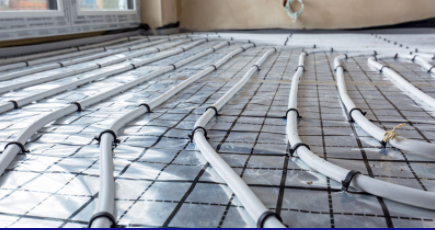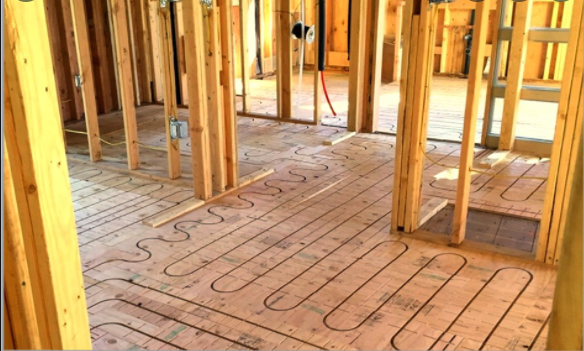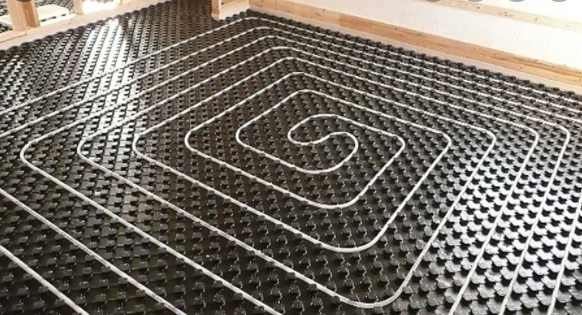You might have heard of heating the panels or floorings with the help of steam; the hydronic radiant floor system is more or less similar. Radiant heating is utilized as the older heating system for the home. Usually, that refers to using a radiator for steam heating. This is the traditional method, whereas the electric heating system is expensive, so there is a blend of both, which is efficient and cost-effective—hydronic radiant floor heating is a significant one. In this article, you will find out how it is different from other heating systems but first, let’s just give a quick read to the other types of floor heating systems.
What are the Types of Radiant Floor Heating?

Speaking of radiant floor heating, there are mainly three systems, including primitive, electric cables, and hydronic radiant floor heating.
Primitive Technology is the ancient one that is rarely found in the modern housing system. This technique refers to the raised floor heating that allows the hot air from underneath the floor to maintain a hot and warm ambiance.
Electric cables are the modern solution in which these cables are installed within the floor and the subflooring. This one is ideal and generally used for small spaces. Though it is a modern technology, it is heavy on the pockets if installed in the whole house.
What Is Hydronic Radiant Floor Heating?

Hydronic radiant floor heatingworks on the principles of the conventional heating system; a radiator. It is actually a cost-effective solution for consistent heating compared to the forced air HAVC system. This one is indeed an energy-efficient system for warming the floor by turning it to a radiator without any kind of air pocket.
How does Hydronic Radiant floor Heating work?
The radiant floor heating system is installed during construction. The PEX tubing system offers flexibility which is why it is used for the process. As the floor is sealed, the tube has to be in a loop instead of joints which is set 9 inches apart.
The sub-flooring and tubing possess a coving of concrete, gypcrete, or dry-tamped mortar.
These materials store heat and allow it to radiate uniformly regardless of whether the system is on or not. Ceramic floor tiles are commonly used to complete the floor since they retain heat efficiently.
The manifold, which runs from the room to the system, keeps the water uniformly distributed between lengths of PEX tubing and helps vent the system. A specialized boiler or water heater is at the opposite end of the system, with a circulating pump that pulls water into the system and returns it to the bottom of the boiler to reheat it.
A running system efficiently keeps heat since the water only loses around 10 degrees.
What Should You Consider for the Hydronic Radiant Floor Heating

Though hydronic radiant floor heating provides variants of options but with some limitations. It would be beneficial if you have prior knowledge and planning to have it at your home. Here are the key features
1. Place to Install
The ideal way of installing this system is during the construction period and also if you want to have it in your entire house or in the bedrooms only. The best recommendation for that is to install it in the room where your family usually hangs out, probably the living room.
If you have a busy household then, it should be installed in uncarpeted rooms, living rooms, bathrooms, hallways, or in the kitchen. In the case of the bathrooms, make sure to install them during the construction. For the cooling system it must be installed in the ceilings.
2. Flooring for Radiant Heat
The type of flooring that you have at your home matters a lot and cause a significant impact on the heating system. Here are the options for hydronic radiant floors.
Either Porcelain or Ceramic tiles
To increase better heat conduction, tiles are the most popular and effective as they have the ability to boost and maintain heat.
The Natural Stone
the natural stone works the tiles likewise as they have similar properties as ceramic tiles. They work nicely with the heating system.
Laminated Floor
This type of flooring is also an excellent match for the floor heating system, but you have to be aware of any limitations the manufacturer suggests. This is because water can damage the laminate, so many companies’ average temperature is 85 degrees F.
Wood
Although the wood flooring offers lower heating efficiency, this could still be an option.
However, this will lead to a low time of heat flooring longevity and less efficiency compared to other flooring materials. The engineered wood flooring is the best option since the underlying plywood is less prone to distortion. In order to get flexibility and accommodation of thermal expansion, the solid hardwood should be quarter-sawn.
These were the flooring that suits the hydronic radiant heating system now; let’s discuss the worst ones.
3. Worst Flooring for Radiant Heat.
Adversary to the excellent flooring for radiant heating, there is some floor type that is not promising to the radiant heating system. This includes
Carpet
The carpet itself is made of heavy woven fabric that absorbs heat that makes them bad conductors.
Rubber
This is not a common flooring type, yet this is something terrible in terms of pairing with radiant floor heating. It is not only sticky but also releases a pungent odor with the heat so, clearly, it is a no.
Concrete
In order to maintain a thick hard flooring, concrete disallows any kind of absorption or conductions. This type of flooring will prevent or even halt the heat or any other substance from trespassing.
To Sum Up
The radiant floor heating system has been in the use since the ancient times of Romans to provide uniformity in the floor temperature. This is something that evolved with time, making a blend with the latest technology. Hydronic Radiant floor heating is the right option for that. In this blog, we have shared the basics of it so that you can plan a better floor heating for you house.
